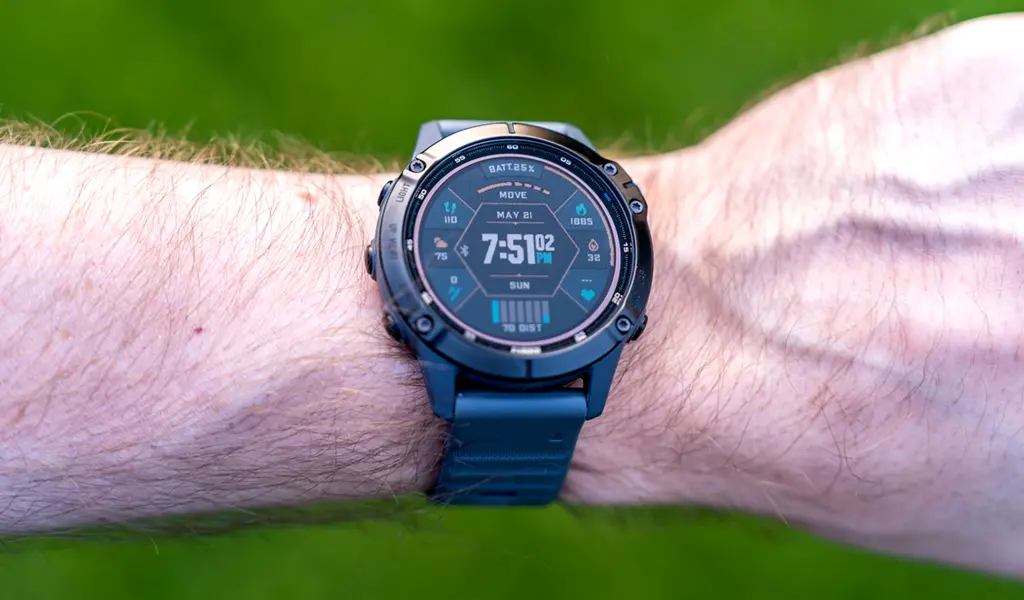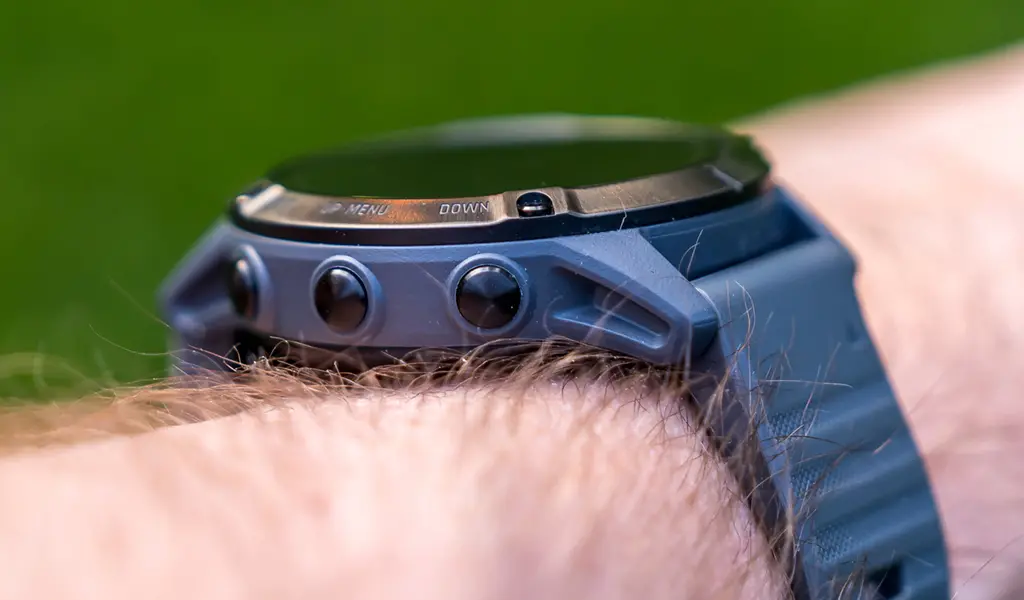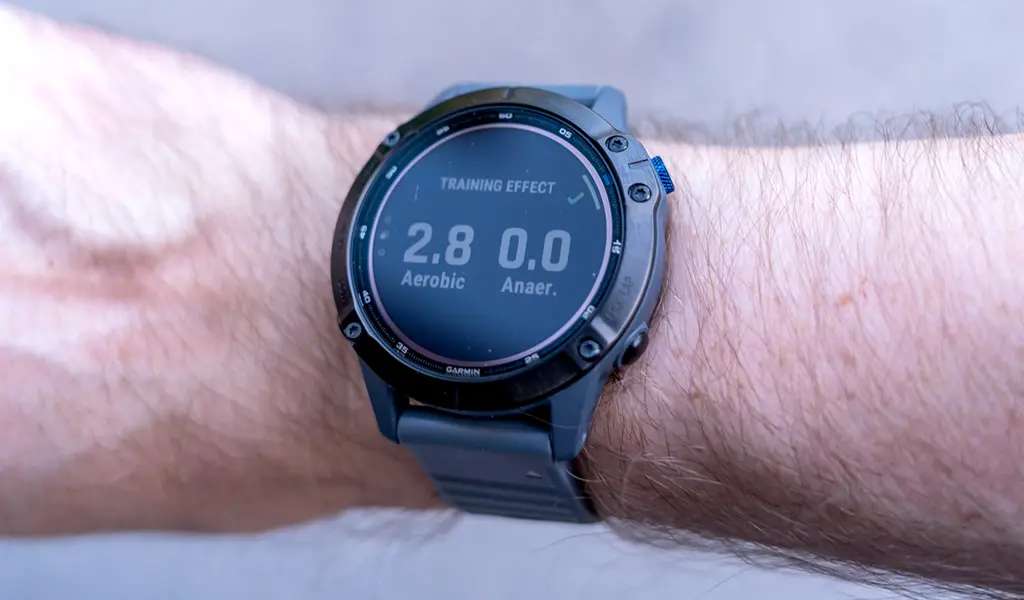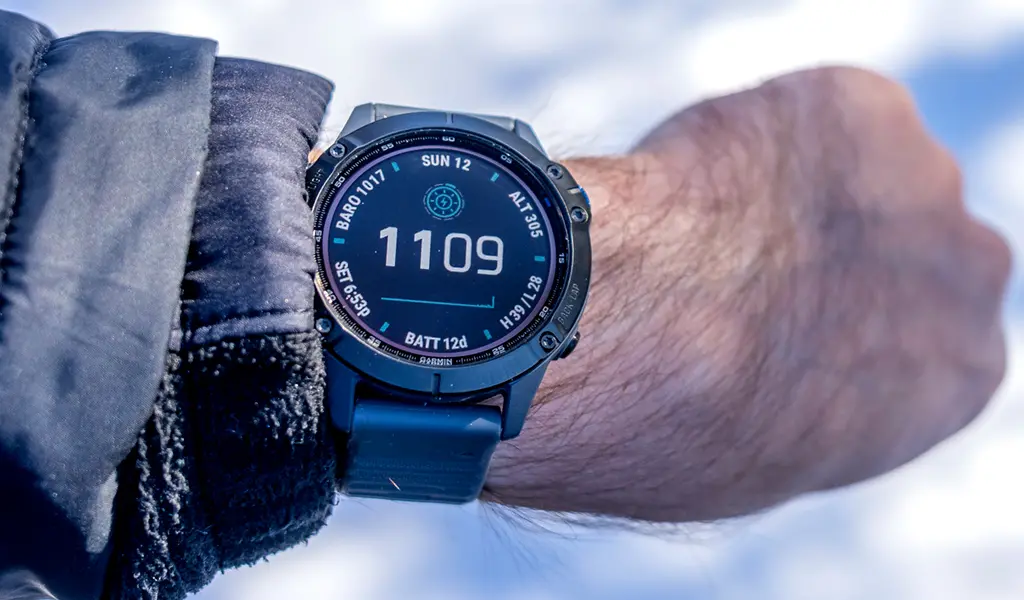
Just looking at the Garmin Fenix 6 Pro Solar gives the impression this smartwatch is serious, and that’s almost a requirement from you to use it too. This isn’t the watch you strap on for show, or to mildly keep tabs on your exercise and health data. You need to be really active to make this watch worth your while and wallet.
I preface this review with that because it’s so critical to getting the most out of this device. Loaded with sensors and features to motivate regular activity, Garmin threw what it could into it to keep even the more demanding runners and trainers happy. You don’t have to necessarily be a runner to wear and get the most out of it, but the company’s pedigree in that area is certainly worthy. I spent three months with it, and got a really good sense of what you can expect if you choose it for your wrist.
Design points in the Fenix 6 Pro Solar
The Fenix 6 Pro Solar is a big watch by any measure. The 47mm body makes this one harder to manage for smaller wrists, though you may feel differently if you get the chance to try one on. It has a 1.3-inch display with a special coating capable of pulling in solar power to extend battery life even further than it already manages.
It’s also considerably rugged—which is obvious from how it looks—with a mix of stainless steel and coated titanium. So rugged, in fact, it achieves a 10ATM rating, meaning it functions down to depths of 100 metres underwater. Most smartwatches max out at 50, so that’s a big jump.

You’ll find five buttons arrayed around the sides to navigate the interface, since the screen isn’t touch-sensitive. If you’re coming from another smartwatch that relies heavily on the touchscreen, I imagine this setup will initially feel daunting. It certainly did to friends who inquired when they saw this watch on my wrist. It takes time to figure out, requiring patience for the first little while until it becomes old hat.
Garmin uses a proprietary cable and plug to charge the Fenix 6 Pro Solar (as it does for many of its watches), making it all the more important not to lose it. You won’t have to charge this particular watch as often, mind you, but something to be aware of. The straps aren’t especially unique, and you have the flexibility to swap them out for others compatible with the watch, in case that matters to you.
Connectivity and setup

You should fully expect this watch to have GPS, which it does (GLONASS and Galileo too). The onboard sensors include a compass, gyroscope, accelerometer, barometric altimeter, and thermometer. It supports Bluetooth for easy connections to your phone or headphones/earbuds, along with Wi-Fi to speed up syncing and firmware updates.
As for tracking, you get a heart rate monitor and SpO2 sensor to contribute to a broader metric Garmin calls “Body Battery”, which takes tracked data and indicates how prepared your body may be for a workout. It estimates the recovery time you need to rest after working out and then suggests how hard to go once you start. It also takes into account your heart rate variances, past performance data, and sleep quality to make that determination. Even weather and altitude come into play. Put together, it’s a substantive overview that looks out for you.
As deep as the Fenix 6 Pro Solar goes, it won’t necessarily match the accuracy of a chest strap for heart rate data. I say this because if the metrics need to be super precise for whatever you’re training for, any discrepancies could be confusing. It’s not a deal-breaker, but something to consider if you need to supplement the watch with other gear. GPS tracking is superb, and one of the most reliable features available.
You also have the option to log hydration through fluid intake, which the Fenix 6 Pro Solar can then use to help you determine preparedness for any workout. It can even estimate how much you’re sweating.
For any path or course you take, especially if there’s already a map for it, you can get turn-by-turn directions. Some maps are even topographical for a heads up on elevation and terrain along the way. With 32GB of storage, you have space to add apps and music.
The Garmin Connect app plays the active role in initially setting up the watch to pair with your phone, as well as syncing data thereafter. It’s also where you integrate with supported apps, like Strava, among a myriad of others you can throw on there. Since the watch also has Garmin Pay, you can add your debit and credit card (if supported), along with the Starbucks card. And if you want to change the watch face, the app lets you do that effortlessly.
Getting used to the button navigation
The Connect app is deep, as is, whereas the watch’s own interface might not feel quite as intuitive. I can see Apple Watch and Wear OS users unaccustomed to this type of design feeling lost at first. The key lies in the physical buttons and what they do. The top-right button doubles as the exercise shortcut and menu selection. Press the bottom left button to go back. The top-left lights up the screen, while the two below navigate up and down. Hold the up button to access a variety of settings, and the down one to access Spotify and music. Hold the light button and you get a rotary menu for more settings and features navigable via the other buttons.
It’s worth taking the time to set things up how you want, but you may not cover everything in one go. The Fenix 6 Pro Solar is full of teaching moments, not just for your activity goals, but also in what it can do for you. No touchscreen may feel weird for a while, but don’t be surprised if you get used to it faster than expected.
Fenix 6 Pro Solar activity and tracking

Garmin offers a ridiculous level of choice in this watch. If you’re into sports on top of just working out, I don’t think you will be disappointed. There are features for skiing, surfing, golfing, climbing, rowing, mountain biking, and more. While there may not be specifics for sports like hockey, basketball or baseball, where wearing a watch might be inadvisable, you can still get plenty of tracking for those too.
You will find dozens of exercises in the Connect app with an impressive level of specificity. For instance, biking splits into separate activities—be it mountain, touring, gravel, road, commute, cyclocross, or eBike. You see similar results for running, skiing, and swimming. Pilates and yoga are in there, plus horseback riding, pickleball, kayaking, stair climbing, and fishing, among so many others.
If you’re a runner, you get to choose from track, indoor track, trail, ultra, treadmill, and virtual. Is there anything missing amongst that group? Combine all that with the various maps available and you have a pretty comprehensive situation for each exercise.
To navigate all this on the watch requires some basic knowledge, but to see what the data means, you go to the Connect app on your phone. That’s where you’ll see heart rate, intensity minutes, calories, respiration data, and more. Tap the menu at the top left to dig deeper on health and performance metrics, as well as plan training and workouts. PacePro is cool in how it helps to develop a pacing strategy based on a course and its terrain. You can even add details about the shoes and other gear you use for running or any other activity to keep track of how long they’ll last.

Apps and notifications

The Fenix 6 Pro Solar doesn’t care if it’s paired with an iPhone or Android phone, but you might if you’re looking for more. They don’t integrate all that much, so as a true smartwatch, Garmin can only deliver so much. You will see notifications pop up on a wide variety of apps, including incoming messages and phone calls, but you can’t really do much with them. The Connect app lets you send a canned response for text messages and phone calls, but that’s about it.
While you can find apps to install through Connect (and Connect IQ), they’re of limited appeal and variance. Spotify is the only real music option. There are no major apps for things like social media, rideshare, loyalty cards, and other things like that. Nor can you integrate with major voice assistants. If you’re only interested in what this watch does from an activity standpoint, then you’re good. If you prefer something with more apps, you’re forced to accept the trade-off.
Garmin Fenix 6 Pro Solar battery life
I doubt you would find battery life to be a problem with this watch. The Fenix 6 Pro Solar can last up to 16 days per charge, which is already solid. Add the solar-charging feature through the screen and you can slow down battery loss even further. The more time you spend outside, the more you expose the watch to solar power. The Solar Intensity section in the Connect app provides insight into how much power the watch took in.
You can expect a good two weeks out of it anyway, which is an eternity compared to most smartwatches. Leave GPS on 24/7 and you will cut that down between 7 to 10 days. For outdoor activity or indoor workouts, it gives you some peace of mind knowing you won’t have to charge it every other day. Even better, you can sleep with it on for multiple nights uninterrupted.
Final thoughts
If I haven’t made it clear already, the Fenix 6 Pro Solar wasn’t built for casual tracking. You strap this on when your lifestyle or activity goals demand something elaborate and focused. The sheer level of tracking and data involved gives you the tools to keep tabs on your progress, including estimates on when it’s best to go hard or take it slower. If that sort of sophistication also results in fewer injuries, then I’m all for it myself.
The Garmin Fenix 6 Pro Solar is available now on bestbuy.ca. For something even bigger, you can check out the Fenix 6X Sapphire.
The post Garmin Fenix 6 Pro Solar smartwatch review appeared first on Best Buy Blog.
